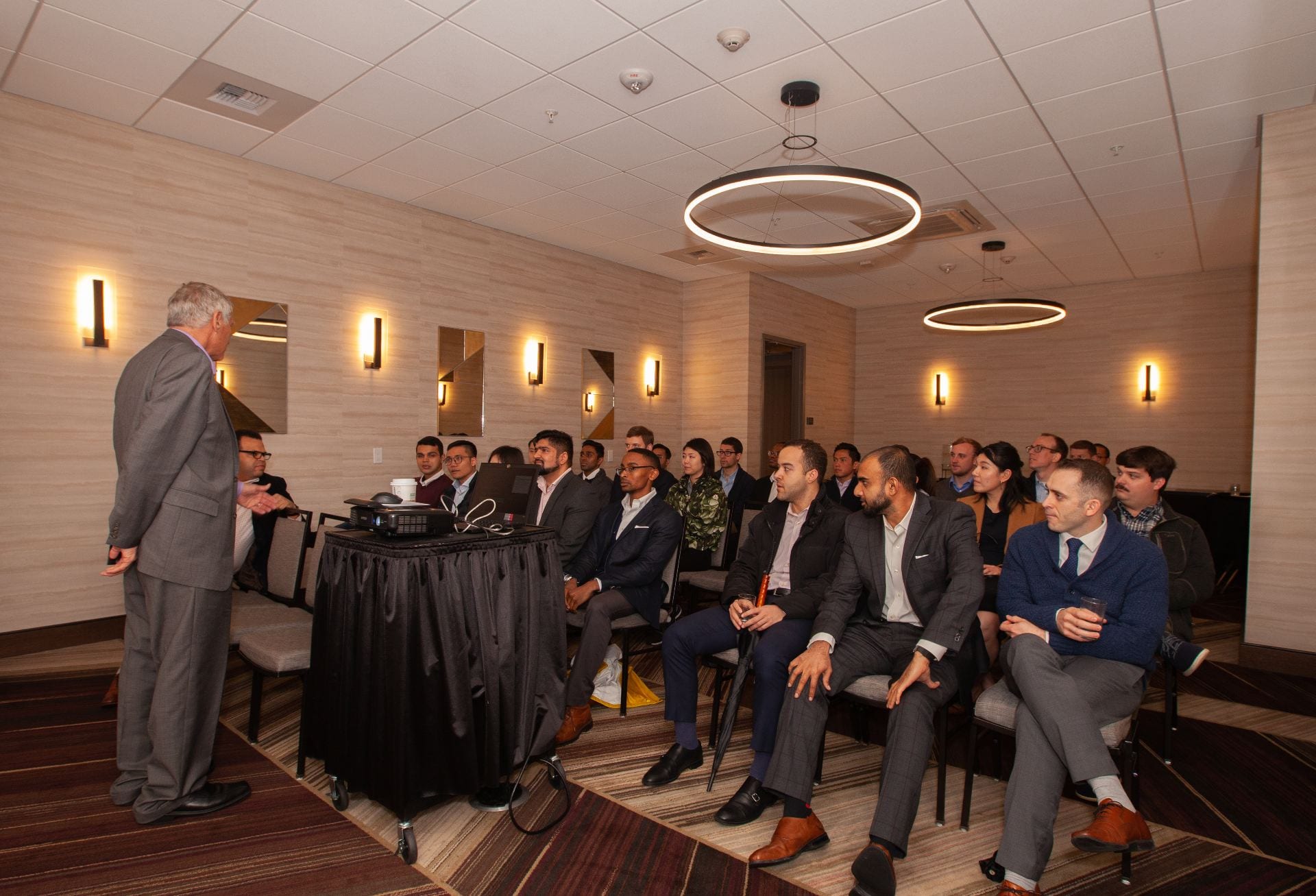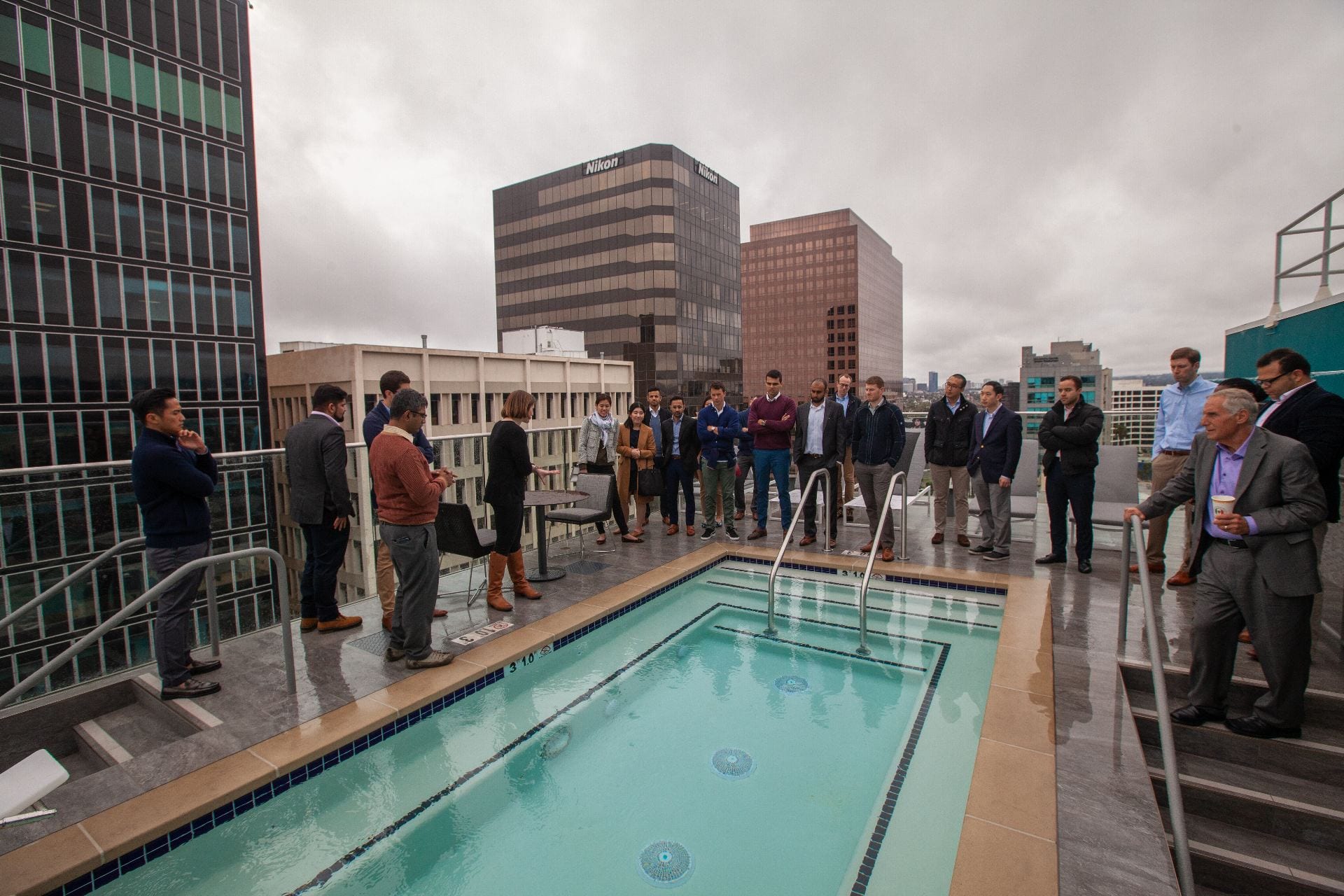On the second day of their domestic trek to Los Angeles, first year Baker students visited three office to hotel conversions as well as a luxury apartment building. The three hotels were owned and developed by Seaview Investors, LLC (Seaview), a California-based real estate investment management company owned by Robert (Bob) Alter (SHA ’73), the Chairman of the Dean’s Advisory Board at Cornell’s Hotel School.

The first two hotels, a Residence Inn by Marriott and a dual-branded hotel consisting of a Homewood Suites and H Hotel, were both located immediately adjacent to the Los Angeles International Airport (LAX) and had been completed over the past few years. The Residence Inn is located in a former 1980s era office building that overlooked LAX’s south runway. This hotel features 231 guest rooms and includes amenities such as an outdoor heated pool, fitness center, and tenants including a Starbucks Coffee and Jersey Mike’s Subs. Students learned about how this was the first Residence Inn in the LAX submarket and how that provided significant opportunities for travelers looking for Residence Inn amenities such as full kitchens. The site, however, is not without challenges. Residence Inns thrive on extended stays (five or more nights) while travelers staying in airport hotels typically only stay a night or two. In addition, given this building’s past as an office building, the floor plates were larger than ideal for a hotel, resulting in large guest suites.
When Seaview purchased the property, the building still had office tenants, and students heard how it proved to be a longer and more expensive process than was predicted to buy out the existing tenant leases. Thus, when Seaview had the opportunity to buy the office building down the street from the Residence Inn that became the dual-branded hotel, the company required the seller to remove the existing tenants as a condition of closing. After the tenants were removed and the sale closed, one of the biggest challenges that Seaview faced when re-developing this building was complying with a recent law requiring earthquake retrofitting of buildings of this age and construction. Bob explained this process, which included digging a deep trench around the exterior perimeter of the building and driving piles deep into the ground. A steel exoskeleton was then attached to these pilings and attached to each of the sides of the building so that the building would be held in place in the event of a strong earthquake. Seaview shrouded this exoskeleton on three sides of the building with decorative sheathing to enhance the hotel’s exterior appearance.

Bob explained how, with two hotel flags operating under the same roof, Seaview is able to offer differentiated products to travelers while consolidating back-of-the-house operations. Indeed, Homewood Suites provides full kitchens for more budget-conscious travelers while H Hotels is Part of Hilton’s higher-end Curio Collection and, as a result, provides more luxury and amenities, including an expanded gym as well as a private rooftop deck. Both hotels enjoy unusually high ceilings and more spacious layouts due to the building’s design as an office building.
The day’s final hotel was an AC Hotel located in the Beverly Hills area. AC Hotel is a relatively new hotel brand in the United States operated by Marriott that fuses style with a certain sensibility. Baker Program students were toured around this hotel by Hannah Greenberg (SHA ’11), who serves as Seaview’s Vice President of Hotel Development, and heard in detail the many challenges that Seaview faced when redeveloping this property. For example, the exterior of the building, despite not necessarily having any considerable historical significance, was nevertheless protected and thus had to be maintained in substantially its original form. This resulted in significant design challenges and cost increases. In addition, like the dual-branded hotel, this building also required earthquake retrofitting. However, students heard how the solution used with the dual-branded hotel – the steel exoskeleton – could not be utilized in this case given the protected status of the building’s exterior. Instead, Seaview had to cut a whole in the concrete slab on the first floor of the building in order to lower a compact pile-driver into the building’s basement where it would drill dozens of micro-piles to secure the buildings. With the basement’s low clear heights and the area’s construction regulations permitting construction only at certain times, this was a slow and arduous process. Bob and Hannah cautioned students on the uncertainties involved in the cost and timing of performing these retrofits, stating that his engineer suggested that it may be prudent to purchase a concrete building in Los Angeles requiring retrofitting until the process and costs associated with doing so are better known.
Another challenge Seaview faced at the AC Hotel was the installation of the rooftop pool, which required significant reinforcement to the floor immediately below and resulted in lower ceiling heights on that floor. The pool is an important amenity for the hotel as is the rooftop deck on the rear of the property that has views of the Hollywood hills and many Los Angeles-area landmarks. Due to these challenges, completion of the hotel was delayed many months, with opening scheduled for the day following the tour.

The final visit of the day was to Ten Thousand, a 40-story, 283-unit luxury apartment building that is also located in the Beverly Hills area. The building is owned by Crescent Heights, a vertically-integrated real estate firm that specializes in the development and operation of architecturally distinctive residential high-rises in gateway markets across the United States. Bruce Menin, a principal of Crescent Heights, visited Cornell as part of the Baker Program’s Fall 2018 Distinguished Speaker Series. As a result, Baker students were provided a rare and exclusive tour of this property where rents start around $10,000 per month and increase up to $65,000 per month for the penthouse.
Ten Thousand represents a unique vision that provides elevated design (the building was designed by Handel Architects), high-end finishes, and resort-style amenities (including 75,000 square feet of indoor and outdoor amenities comprising two pools, spa, tennis and basketball courts, complementary continental breakfast, residents’ lounge, state-of-the-art gym, exercise studios, movie theater, screening room, game room, boardrooms, and a one acre park accessible only be residents and their guests). Students were impressed by the amenities, with Joanne Angbazo remarking “that the amenities at Ten Thousand meet and even exceed the level of amenities one would expect at a five-star hotel.” At the time of the visit, the building was more than 90% occupied with a wait-list for certain units.

Technology lies at the heart of Ten Thousand. For example, many of the building’s services can be accessed via a proprietary app, such as requesting that a valet pull a resident’s car to the front door. Additionally, Ten Thousand, as well as all of the hotels that were visited, offer robotic butlers that provide deliver guests/residents with items such as bottled water, toothpaste, etc. The Then Thousand robot is able to navigate the entire building and enables personnel to focus their energies on more important tasks. “Real estate has lagged other industries in incorporating cutting-edge technology, but that is finally starting to change,” stated Kunal Kataria, who is planning to take the Real Estate Technology and Innovation class offered at Cornell Tech’s New York City campus.
